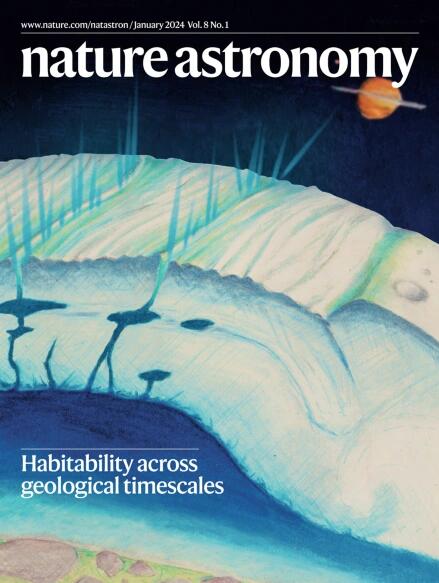木星大气流体力学模型支持的超极地氧气丰度
IF 12.9
1区 物理与天体物理
Q1 ASTRONOMY & ASTROPHYSICS
引用次数: 0
摘要
木星的氧气含量与其形成历史和早期太阳系的演化密不可分。最近对一氧化碳的一维热化学建模显示,木星的大体积水含量可能在太阳系下,这与利用朱诺号航天器测定的赤道附近的富水情况形成了鲜明对比。在这里,我们利用流体力学模型研究木星在水云层及以下的大气动力学,并通过简化的热化学模型显示流体力学对对流层中不平衡物种 CO、PH3 和 GeH4 丰度的影响。如果 PH3 和 GeH4 只提供了氧气丰度的上限(≤5 倍太阳时),那么我们的结果表明,使用更新的 CO 热化学方法,氧气丰度范围为 2.5-5 倍太阳时。利用传统的一氧化碳化学时间尺度,我们进一步揭示了潮湿对流与水云层一氧化碳丰度之间的相关性。如果这种相关性在观测中被发现,那么它将有利于木星在雪线附近的形成,因为那里蕴藏着超太阳的氧气丰度。本文章由计算机程序翻译,如有差异,请以英文原文为准。


A supersolar oxygen abundance supported by hydrodynamic modelling of Jupiter’s atmosphere
Jupiter’s oxygen content is inextricably tied to its formation history and the evolution of the early Solar System. Recent one-dimensional thermochemical modelling of CO showed that the planet’s bulk water content could be subsolar, in stark contrast to the water enrichment determined near the equator using the Juno spacecraft. Here we use a hydrodynamic model to study Jupiter’s atmospheric dynamics at and below the water cloud level with simplified thermochemistry to show the effect of hydrodynamics on the abundance of disequilibrium species CO, PH3 and GeH4 in the troposphere. If PH3 and GeH4 provide only an upper limit for the oxygen abundance (≤5 times solar), our results suggest an oxygen enrichment range of 2.5–5 times solar using updated CO thermochemistry. Using the conventional CO chemical timescale, we further reveal a correlation between moist convection and the CO abundance at the water cloud level. If such a correlation is found observationally, it would favour the formation of Jupiter near the snow line, which harbours a supersolar oxygen abundance. Numerical simulations of Jupiter’s atmosphere, using gases that are tied to the deep regions of the planet, show that the amount of water that is hidden deep inside Jupiter is supersolar, with oxygen abundance between 2.5 and 5 times the solar value.
求助全文
通过发布文献求助,成功后即可免费获取论文全文。
去求助
来源期刊

Nature Astronomy
Physics and Astronomy-Astronomy and Astrophysics
CiteScore
19.50
自引率
2.80%
发文量
252
期刊介绍:
Nature Astronomy, the oldest science, has played a significant role in the history of Nature. Throughout the years, pioneering discoveries such as the first quasar, exoplanet, and understanding of spiral nebulae have been reported in the journal. With the introduction of Nature Astronomy, the field now receives expanded coverage, welcoming research in astronomy, astrophysics, and planetary science. The primary objective is to encourage closer collaboration among researchers in these related areas.
Similar to other journals under the Nature brand, Nature Astronomy boasts a devoted team of professional editors, ensuring fairness and rigorous peer-review processes. The journal maintains high standards in copy-editing and production, ensuring timely publication and editorial independence.
In addition to original research, Nature Astronomy publishes a wide range of content, including Comments, Reviews, News and Views, Features, and Correspondence. This diverse collection covers various disciplines within astronomy and includes contributions from a diverse range of voices.
 求助内容:
求助内容: 应助结果提醒方式:
应助结果提醒方式:


